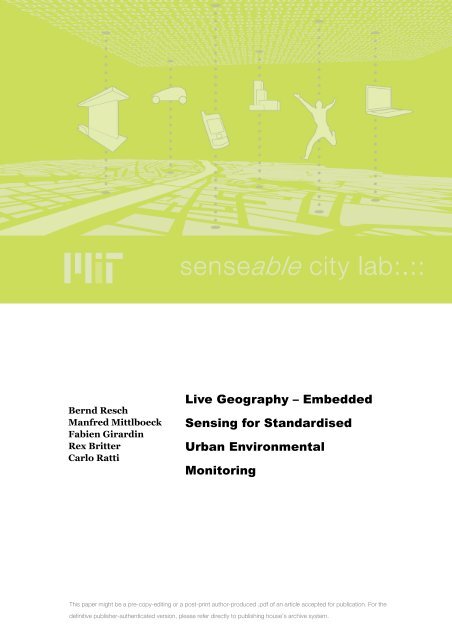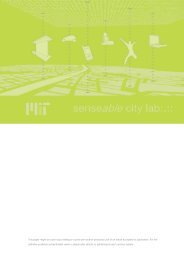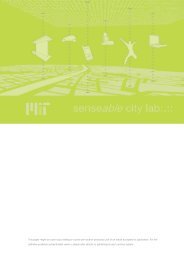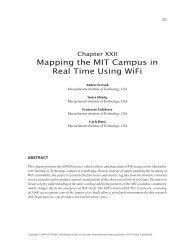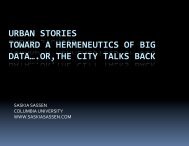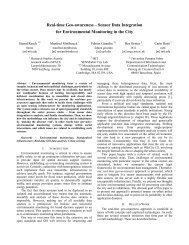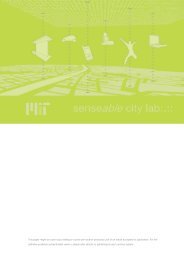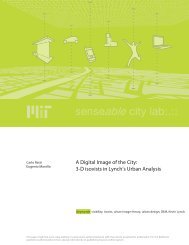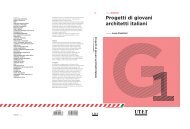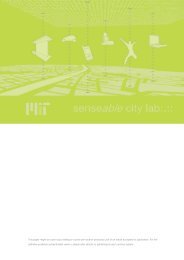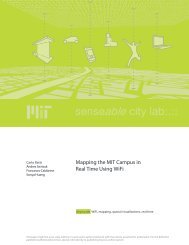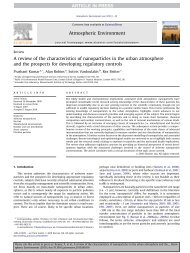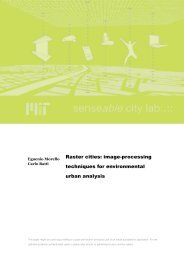Embedded Sensing for Standardised Urban Environmental Monitoring
Embedded Sensing for Standardised Urban Environmental Monitoring
Embedded Sensing for Standardised Urban Environmental Monitoring
You also want an ePaper? Increase the reach of your titles
YUMPU automatically turns print PDFs into web optimized ePapers that Google loves.
Bernd ReschManfred MittlboeckFabien GirardinRex BritterCarlo RattiLive Geography – <strong>Embedded</strong><strong>Sensing</strong> <strong>for</strong> <strong>Standardised</strong><strong>Urban</strong> <strong>Environmental</strong><strong>Monitoring</strong>This paper might be a pre-copy-editing or a post-print author-produced .pdf of an article accepted <strong>for</strong> publication. For thedefinitive publisher-authenticated version, please refer directly to publishing house’s archive system.
Live Geography – <strong>Embedded</strong> <strong>Sensing</strong> <strong>for</strong><strong>Standardised</strong> <strong>Urban</strong> <strong>Environmental</strong> <strong>Monitoring</strong>Bernd Resch 1,2Research Scientistberno[at] mit.eduMember, IEEEManfred Mittlboeck 1Key Researchermanfred.mittlboeck[at] researchstudio.atFabien Girardin 2,3Researcherfabien.girardin[at] upf.eduRex Britter 2Visiting Professorrb11[at] eng.cam.ac.ukCarlo Ratti 2Director andAssociate Professorratti[at] mit.edu1 Research Studios Austriastudio iSPACELeopoldskronstrasse 305020 Salzburg, Austria2 MITSENSEable City Lab77 Massachusetts Avenuebuilding 10, room 400Cambridge, MA 02139, USA3 Universitat Pompeu FabraDepartment of In<strong>for</strong>mation andCommunication TechnologiesPasseig de Circumval.lació 808003 Barcelona, SpainAbstract – <strong>Environmental</strong> monitoring faces a variety ofcomplex technical and socio-political challenges, particularly inthe urban context. Data sources may be available, but mostlynot combinable because of lacking interoperability anddeficient coordination due to monolithic and closed datainfrastructures. In this work we present the Live Geographyapproach that seeks to tackle these challenges with an opensensing infrastructure <strong>for</strong> monitoring applications. Our systemmakes extensive use of open (geospatial) standards throughoutthe entire process chain – from sensor data integration toanalysis, Complex Event Processing (CEP), alerting, andfinally visualisation. We discuss the implemented modules aswell as the overall created infrastructure as a whole. Finally,we show how the methodology can influence the city and itsinhabitants by „making the abstract real“, in other words howpervasive environmental monitoring systems can change urbansocial interactions, and which issues are related to establishingsuch systems.Keywords – <strong>Urban</strong> environmental monitoring; <strong>Standardised</strong>infrastructure; Real-time GIS data analysis; Situationalawareness; <strong>Embedded</strong> sensor device.I. INTRODUCTION<strong>Environmental</strong> monitoring is a critical process in cities toensure public safety including the state of the nationalinfrastructure, to set up continuous in<strong>for</strong>mation services andto provide input <strong>for</strong> spatial decision support systems.However, setting up an overarching monitoring system is nottrivial. Currently, different authorities with heterogeneousinterests each implement their own monolithic infrastructuresto achieve very specific goals, as stated in our previous work[1]. For instance, regional governments measure water levels<strong>for</strong> flood water prediction, while local governments monitorair quality to dynamically adapt traffic conditions, andenergy providers assess water flow in order to estimateenergy potentials.The fact that these systems tend to be deployed in anisolated and uncoordinated way means that the automaticassembly and analysis of these diverse data streams isimpossible. However, making use of all available datasources is a prerequisite <strong>for</strong> holistic and successfulenvironmental monitoring <strong>for</strong> broad decision support in anurban context. This applies to emergency situations as wellas to continuously monitoring urban parameters.One way to overcome this issue is the extensive use ofopen standards and Geographic In<strong>for</strong>mation System (GIS)web services <strong>for</strong> structuring and managing theseheterogeneous data. Here, the main challenge is thedistributed processing of vast amounts of sensor data in realtime,as the widespread availability of sensor data with highspatial and temporal resolution will increase dramaticallywith rapidly decreasing prices [2], particularly if costs aredriven down by mass utilisation.From a political and legal standpoint, national andinternational legislative bodies are called upon to foster theintroduction of open standards in public institutions. Strongearly ef<strong>for</strong>ts in this direction have been made by theEuropean Union (EU) through targeted directives (s. chapterIV). These regulations support the development ofubiquitous and generically applicable real-time dataintegration mechanisms. Shifting development away fromproprietary single-purpose implementations towardsinteroperable analysis systems will not only enable liveassessment of the urban environment, but also lead to a newperception of the city by its inhabitants. Consequently, thismay in turn foster the creation of innovative applications thattreat the city as an interactive sensing plat<strong>for</strong>m, such asWikiCity [3], involving the people themselves into reshapingthe urban context.
This paper begins with a review of related work inseveral research areas. Then, challenges of environmentalmonitoring with particular respect to the urban context areelucidated, be<strong>for</strong>e we summarise the current legalframeworks <strong>for</strong> environmental data management. Thereafter,our Live Geography approach is presented, which aims tointegrate live sensor measurements with archived datasources on the server side in a highly flexible andinteroperable infrastructure. Finally, we present our thoughtson how environmental sensing and Geographic In<strong>for</strong>mation(GI) processing can affect the city and its inhabitants. Theultimate goal of this paper is to present our approach’spotential impact on urban policy and decision-making, and topoint out its portability to other application domains.II. RELATED WORKThe Live Geography approach is manifold in terms ofboth concepts and employed technologies. As such, there areseveral research initiatives that <strong>for</strong>m part of the overallmethodology. These are described below.The first domain is sensor network development <strong>for</strong>environmental monitoring. The Oklahoma City Micronet[4] is a network of 40 automated environmental monitoringstations across the Oklahoma City metropolitan area. Thenetwork consists of 4 Oklahoma Mesonet stations and 36sites mounted on traffic signals. At each traffic signal site,atmospheric conditions are measured and transmitted everyminute to a central facility. The Oklahoma ClimatologicalSurvey receives the observations, verifies the quality of thedata and provides the data to Oklahoma City Micronetpartners and customers. One major shortcoming of thesystem is that it is a much specialised implementation notusing open standards or aiming at portability. The sameapplies to CORIE [5], which is a pilot environmentalobservation and <strong>for</strong>ecasting system (EOFS) <strong>for</strong> the ColumbiaRiver. It integrates a real-time sensor network, a datamanagement system and advanced numerical models.Secondly, there are a number of approaches toleveraging sensor in<strong>for</strong>mation in GIS applications. [6]presents the SenseWeb project, which aims to establish aWikipedia-like sensor plat<strong>for</strong>m. The project seeks to allowusers to include their own sensors in the system and thusleverage the „community effect“, building a dense networkof sensors by aggregating existing and newly deployedsensors within the SenseWeb application. Although theauthors discuss data trans<strong>for</strong>mation issues, data fusion, andsimple GIS analysis, the system architecture is not based onopen (geospatial) standards, only standard web services. Theweb portal implementation, called SensorMap, uses theSensor Description Markup Language (SDML), anapplication-specific dialect of the Open GeospatialConsortium (OGC) SensorML standard.In [7], the author presents a sensing infrastructure thatattempts to combine sensor systems and GIS-basedvisualisation technologies. The sensing devices, whichmeasure rock temperature at ten minute intervals, focuses onoptimising resource usage, including data aggregation,power consumption, and communication within the sensornetwork. In its current implementation, the infrastructuredoes not account <strong>for</strong> geospatial standards in sensorobservations. The visualisation component uses a number ofopen standards (OGC Web Map Service [WMS], WebFeature Service [WFS]) and open-source services (UMNMap Server, Mapbender).Another sensing infrastructure is described in [8]. TheCitySense project uses an urban sensor network to measureenvironmental parameters and is thus the data source <strong>for</strong>further data analysis. The project focuses on the developmentof a city-wide sensing system using an optimised networkinfrastructure. An important parallel with the work presentedin this paper is that CitySense also considers therequirements of sensor network setup in an urbanenvironment.A GIS mashup <strong>for</strong> environmental data visualisation ispresented in the nowCOAST application [9]. Data fromseveral public providers are integrated in a web-basedgraphical user interface. nowCOAST visualises several typesof raw environmental parameters and also offers a 24-hoursea surface temperature interpolation plot.The most striking shortcoming of the approachesdescribed above and other related ef<strong>for</strong>ts is that their systemarchitectures are at best partly based on open (geospatial)standards.The third related research area is real-time dataintegration <strong>for</strong> GIS analysis systems. Most currentapproaches use web services based on the classicrequest/response model. Although partly using open GISstandards, they are often unsuitable <strong>for</strong> the real-timeintegration of large volumes of data. [10] establishes a realtimespatial data infrastructure (SDI), which per<strong>for</strong>ms severalapplication-specific steps (coordinate trans<strong>for</strong>mation, spatialdata generalisation, query processing or map rendering andadaptation), but accounts neither <strong>for</strong> event-based pushmechanisms nor <strong>for</strong> the integration of sensor data.Other approaches <strong>for</strong> real-time data integration rely onthe costly step of creating a temporal database. Oracle’ssystem, presented in [11], is essentially a middlewarebetween (web) services and a continuously updated databaselayer. Like Sybase’s method [12], the Oracle approachdetects database events in order to trigger analytical actionsaccordingly. In [13], a more dynamic method of dataintegration and fusion is presented using on-the-fly objectmatching and metadata repositories to create a flexible dataintegration environment.The fourth comprised research field is the developmentof an open data integration system architecture in a nonapplication-specificinfrastructure. Recent research ef<strong>for</strong>tsfocus on general concepts in systems architecturedevelopment and data integration, but there are mostly noconcrete conclusions as to how to establish such aninfrastructure. A more technical approach <strong>for</strong> ad-hoc sensornetworks is described in [14], where the authors discussapplication-motivated challenges to combiningheterogeneous sensor measurements through highly flexiblemiddleware components. The method is strongly applicationmotivatedand thus very well-thought-out as far as specificimplementation details are concerned.
III.CHALLENGES OF URBAN ENVIRONMENTALMONITORING AND SENSINGThe urban context poses many challenges toenvironmental monitoring: not only are there significanttechnical and technological issues, but also social andpolitical ones as well.The key technological challenge is the integration ofdifferent data sources owned by governmental institutions,public bodies, energy providers and private sensor networkoperators. This problem can be tackled with self-containedand well-conceived data encapsulation standards –independent of specific applications – and en<strong>for</strong>ced by legalentities, as discussed in chapter IV. However, the adaptationof existing sensors to new standards is costly <strong>for</strong> data ownersand network operators in the short term, and so increasedawareness of the benefits of open standards is required.From a technical viewpoint, unresolved researchchallenges <strong>for</strong> ubiquitous urban monitoring infrastructuresare manifold and include: finding a uni<strong>for</strong>m representationmethod <strong>for</strong> measurement values, optimising data routingalgorithms in multi-hop networks, and developing optimaldata visualisation and presentation methods. The last is anessential aspect of decision support systems, as different usergroups might need different views of the underlyingin<strong>for</strong>mation. For example, in emergency local authoritiesmight want a socio-economic picture of the affected areas,while first-response <strong>for</strong>ces are interested in topography andpeople’s current locations, and the public might want generalin<strong>for</strong>mation about the predicted development of a disaster.From a more contextual standpoint, an importantpeculiarity of the urban context is that there are largevariations within continuous physical phenomena over smallspatial and temporal scales. For instance, due totopographical, physical or optical irregularities, pollutantconcentration can differ considerably, even on opposite sidesof the street. This variability tends to make individual pointmeasurements less likely to be representative of the systemas a whole. The consequence of this dilemma is an evolvingargument <strong>for</strong> environmental regulations based oncomprehensive monitoring data rather than mathematicalmodelling, and this demand is likely to grow. Consequently,the deployment of many sensors allows <strong>for</strong> morerepresentative results together with an understanding oftemporal and spatial variability.One way to overcome this issue is to „sense people” andtheir immediate surroundings using everyday devices such asmobile phones or cameras. These can replace – or at leastcomplement – the extensive deployment of specialised citywidesensor networks. The basic trade-off of this peoplecentricapproach is between cost efficiency and real-timefidelity. We believe that the idea of using existing devices tosense the city is crucial, but that it requires more research onsensing accuracy, data accessibility and privacy, locationprecision, and interoperability in terms of data and exchange<strong>for</strong>mats. Furthermore, measurements are only available in aquasi-continuous distribution due to the high spatial andtemporal variability of ad-hoc data collection. Addressingthis issue will require complex distribution models andefficient resource discovery mechanisms in order to ensureadaptability to rapidly changing conditions.Another central issue in deploying sensor networks in thecity is the impact of fine-grained urban monitoring, as termslike „air quality” or „pollutant dispersion” are only asurrogate <strong>for</strong> a much wider and more direct influence onpeople, such as life expectation, respiratory diseases orquality of life. This raises the demand of finding the rightlevel of in<strong>for</strong>mation provision. More accurate, finer-grainedor more complete in<strong>for</strong>mation might in many cases notnecessarily be worthwhile having, as this could allow <strong>for</strong>drawing conclusions on a very small scale, in extreme caseseven on the individual. This again could entail a dramaticimpact in a very wide range of areas like health care, theinsurance sector, housing markets or urban planning andmanagement.Finally, some more unpredictable challenges posed bythe dynamic and volatile physical environment in the city areradical weather conditions, malfunctioning hardware,connectivity, or even theft and vandalism.IV.POLICY-FRAMEWORKS FOR THE INTEGRATION OFREAL-TIME SENSOR INFORMATIONAs mentioned above, we have seen an explosion ofspatial data collection and availability in digital <strong>for</strong>m in thepast several years. There are various national andinternational ef<strong>for</strong>ts to establish spatial data infrastructures(SDI) <strong>for</strong> promoting and sharing geospatial in<strong>for</strong>mationthroughout governments, public and private organisationsand the academic community. It is a substantial challengesolving the political, technological and semantic issues <strong>for</strong>sharing geographic in<strong>for</strong>mation to support decision makingin an increasingly environment-oriented world. In 2007, theUnited Nations Geographic In<strong>for</strong>mation Working Grouppublished a report subsuming recent regional national andinternational technologies, policies, criteria, standards andpeople necessary to organise and share geographicin<strong>for</strong>mation. These include real-time location aware sensormeasurements to develop a United Nations Spatial DataInfrastructure (UNSDI) and encourage interoperabilityacross jurisdictions and between UN member states. Asdescribed, these SDIs should help stimulate the sharing andre-use of expensive geographic in<strong>for</strong>mation in several ways:• The Global Spatial Data Infrastructure Associationis one of the first organisations to promoteinternational cooperation in developing andestablishing local, national and international SDIsthrough interaction between organisations andtechnologies supported by the U.S. GeologicalSurvey (USGS).• On a supra-national level, the INfrastructure <strong>for</strong>SPatial In<strong>for</strong>mation in Europe (INSPIRE) aims toenable the discovery and usage of data <strong>for</strong> analysingand solving environmental problems by overcomingkey barriers such as inconsistency in data collection,a lack of documentation, and incompatibilitybetween legal and geographic in<strong>for</strong>mation systems.
• Global <strong>Monitoring</strong> <strong>for</strong> Environment and Security(GMES) is another European Initiative <strong>for</strong> theimplementation of in<strong>for</strong>mation services dealing withenvironmental and security issues using earthin<strong>for</strong>mation and in-situ data <strong>for</strong> the short, mid andlong-term monitoring of environmental changes.This is Europe’s main contribution to the Group ofEarth Observations (GEO) <strong>for</strong> monitoring andmanagement of planet earth.• Global Earth Observation System of Systems(GEOSS) seeks to establish an overarching systemon top of national and supra-national infrastructuresto provide comprehensive and coordinated earthobservation <strong>for</strong> trans<strong>for</strong>ming these data into vitalin<strong>for</strong>mation <strong>for</strong> society.The common goal of all these initiatives – and thenumerous national SDI approaches – is the integration andsharing of environmental in<strong>for</strong>mation comprising remotesensing data, geographic in<strong>for</strong>mation and (real-time)measurement data sets. With the European Shared<strong>Environmental</strong> In<strong>for</strong>mation System (SEIS), a new concepthas been introduced to collect, analyse and distribute thesein<strong>for</strong>mation sets in a loosely coupled, „federal“ structurefocused on defining interfaces. A particular focus isdedicated to near real-time datasets like sensormeasurements. This new flexibility should foster theintegration of sensor measurements into existing SDIs.V. LIVE GEOGRAPHY APPROACHWith the above mentioned challenges to urbanmonitoring and standardisation in mind, we have created theLive Geography approach, which aims to combine livemeasurement data with historic data sources in an openstandards-based infrastructure using server-side processingmechanisms.The system architecture is composed of layers of looselycoupledand service-oriented building blocks, as described inthe following sections. In this way, data integration can bedecoupled from the analysis and visualisation components,allowing <strong>for</strong> flexible and dynamic service chaining. In orderto fulfil real-time data needs and alerting requirements, theconcept also incorporates an event-based push mechanism(sub-section B). As noted above, one of the major challengesis the integration of location-enabled real-time measurementdata into GIS service environments to per<strong>for</strong>m distributedanalysis tasks. There are three main requirements <strong>for</strong> qualityawareGIS analysis: accuracy, completeness and topicality ofthe input data (layers). As recent developments often do notaccount <strong>for</strong> time stamp parameters, it is necessary to identifyeffective ways to combine space and terrestrial real-timeobservation data with SDI in<strong>for</strong>mation layers.Fig. 1 illustrates the basic service infrastructure of theLive Geography concept. The general workflow within theinfrastructure can be followed from left to right. First,heterogeneous data sources, such as sensor data, externaldata (provided via standardised interfaces such as OGC WFSor WCS [Web Coverage Service]) or archived data areintegrated on the server side. This integration can happen viaboth classical request/response models and push services thatsend out alerts, e.g. if a certain threshold is exceeded. Theflexible sensor fusion mechanism supports as well mobile asstatic sensors. Next, the different kinds of data are combinedby a data integration server. This step requires real-timeprocessing capabilities, such as Event Stream Processing(ESP) and Complex Event Processing (CEP). Theharmonised data are then fed to pre-defined GIS processmodels to generate user-specific output.This approach shifts resource-consuming geo-processingoperations away from the client by executing complex,asynchronous analysis tasks on the server side, and thensimply providing the client with a tailored result. The outputcould be an XML structure, a numerical value, or acontextual map tailored to the user’s specific needs. Thecrucial benefit of this approach is that GIS applications – thatpreviously offered GIS functionality only through resourceconsumingdesktop clients – could be replaced bylightweight web-based analysis tools. This enables the resultsof GIS analysis to be delivered to a wide variety of internetconnecteddevices, including personal computers, handhelds,and smart phones, or even other online analytical processes.This also allows <strong>for</strong> real-time situational awareness in spatialdecision support systems. In other words, the system issuitable <strong>for</strong> using GIS-compliant data sets to assess urbanenvironmental conditions and predict, within limits, theirdevelopment in real-time. [15]Figure 1. Live Geography Infrastructure.
A. Usage of Open StandardsThe components of this process chain are separated byseveral interfaces, which are defined using open standards.The first central group of standards is subsumed under theterm Sensor Web Enablement (SWE), an initiative by theOGC that aims to make sensors discoverable, query-able,and controllable over the Internet [16]. Currently, the SWEfamily consists of seven standards, which encompass theentire process chain from making sensors discoverable in aregistry, to measuring physical phenomena, and sending outalerts. [17]• Sensor Model Language (SensorML) – This standardprovides an XML schema <strong>for</strong> defining thegeometric, dynamic and observational characteristicsof a sensor. Thus, SensorML assists in the discoveryof different types of sensors, and supports theprocessing and analysis of the retrieved data, as wellas the geo-location and tasking of sensors.• Observations & Measurements (O&M) – O&Mprovides a description of sensor observations in the<strong>for</strong>m of general models and XML encodings. Thisframework labels several terms <strong>for</strong> themeasurements themselves as well as <strong>for</strong> therelationship between them. Measurement results areexpressed as quantities, categories, temporal orgeometrical values as well as arrays or composites ofthese.• Transducer Model Language (TML) – Generallyspeaking, TML can be understood as O&M’spendant or streaming data by providing a methodand message <strong>for</strong>mat describing how to interpret rawtransducer data.• Sensor Observation Service (SOS) – SOS provides astandardised web service interface allowing access tosensor observations and plat<strong>for</strong>m descriptions.• Sensor Planning Service (SPS) – SPS offers aninterface <strong>for</strong> planning an observation query. Ineffect, the service per<strong>for</strong>ms a feasibility check duringthe set up of a request <strong>for</strong> data from several sensors.• Sensor Alert Service (SAS) – SAS can be seen as anevent-processing engine whose purpose is to identifypre-defined events such as the particularities ofsensor measurements, and then generate and sendalerts in a standardised protocol <strong>for</strong>mat.• Web Notification Service (WNS) – The WebNotification Service is responsible <strong>for</strong> deliveringgenerated alerts to end-users by E-mail, over HTTP,or via SMS. Moreover, the standard provides anopen interface <strong>for</strong> services, through which a clientmay exchange asynchronous messages with one ormore other services.Furthermore, Sensor Web Registries play an importantrole in sensor network infrastructures. However, they are notdecidedly part of SWE yet, as the legacy OGC CatalogueService <strong>for</strong> Web (CSW) is used. The registry serves tomaintain metadata about sensors and their observations. Inshort, it contains in<strong>for</strong>mation including sensor location,which phenomena they measure, and whether they are staticor mobile. Currently, the OGC is pursuing a harmonisationapproach to integrate the existing CSW into SWE bybuilding profiles in ebRIM/ebXML (e-business RegistryIn<strong>for</strong>mation Model).An important ongoing ef<strong>for</strong>t in SWE development is theestablishment of a central SWE Common specification. Itsgoal is to optimise redundancy and maximise reusability bygrouping common elements <strong>for</strong> several standards under onecentral specification.The functional connections between the describedstandards are illustrated in Fig. 2.Figure 2. Functional Connections between the SWE Standards.Besides these sensor-related standards, other OGCstandards are used <strong>for</strong> data analysis and provisioning. TheWeb Processing Service, as described in [18], provides aninterface to access a processing service offering a number ofpre-defined analytical operations – these can be algorithms,simple calculations, or more complex models, which operateon geospatial data. Both vector and raster data can beprocessed. The output of the processes can be either a predefineddata structure such as Geographic Markup Language(GML), geoRSS, Keyhole Markup Language (KML),Scalable Vector Graphics (SVG), or a web-accessibleresource like a JPEG or PNG picture.<strong>Standardised</strong> raw data access is granted by the use ofOGC WFS, WMS and WCS standards. These well-knownstandards provide access to data in various <strong>for</strong>mats such asvectors (points, lines and polygons), raster images, andcoverages (surface-like structures).More about the described sensor related and dataprovision standards can be found on the OGC web site 1 .B. Location-aware Complex Event ProcessingApart from standardised data transmission and provision,a special focus in the Live Geography approach is theextension of Complex Event Processing (CEP) functionalityby spatial parameters. In a geographic context, CEP can <strong>for</strong>instance serve <strong>for</strong> detecting threshold exceedances, <strong>for</strong> geo-1 http://www.opengeospatial.org
fencing implementations, <strong>for</strong> investigating spatial clusters, or<strong>for</strong> ensuring data quality.Generally speaking, CEP is a technology that extractsknowledge from distributed systems and trans<strong>for</strong>ms it intocontextual knowledge. Since the in<strong>for</strong>mation content of thiscontextual knowledge is higher than in usual in<strong>for</strong>mation, thebusiness decisions that are derived from it can be moreaccurate. The CEP system itself can be linked into an EventDriven Architecture (EDA) environment or just be built ontop of it. While the exact architecture depends on theapplication-specific needs and requirements, a generalarchitecture including five steps can be applied to every CEPsystem. Fig. 3 shows this architecture in Job DescriptionLanguage (JDL) [19].Figure 3. General CEP Architecture with Levels of Data Processing. [19]The system is divided into several components (or levels)that represent processing steps. Since individual systemsmay have different requirements the implementation depthwill vary from system to system. The following list notes thebasic requirements <strong>for</strong> each level, according to [19]:• Level 0: Pre-processing – Be<strong>for</strong>e the actualprocessing takes part the data is normalised,validated and eventually pre-filtered. Additionally, itmay be important to apply feature extraction to getrid of data that is not needed. Although this part isimportant <strong>for</strong> the CEP workflow, it is not aparticularity of CEP in general. Thus, it is marked aslevel 0.• Level 1: Event Refinement – This component’s taskis to track and trace an event in the system. After anevent has been tracked down, its characteristics (e.g.data, behaviour and relationships) are translated intoevent-attributes. The tracing part deals with stateestimation that tries to predict upcoming events inthe system.• Level 2: Situation Refinement – The heart of eachCEP system is the step of situation refinement,where the actual analysis of simple and complexevents takes place. This analysis includesmathematical algorithms, which comprise not onlycomputing boundaries <strong>for</strong> certain values, but alsomatching them against patterns and historical data.The results are high level (contextual) interpretationswhich can be acquired in real-time.• Level 3: Impact Assessment – After analysing andrefining the situation, it is important to generatedecisions that may have consequences. Impactassessment deals with the simulation of outcomes. Itthere<strong>for</strong>e deals with various scenarios and simulatesthem by accounting <strong>for</strong> cost factors and resources.Results are weighted decision reports that includepriorities and proposals <strong>for</strong> corresponding scenarios.• Level 4: Process Refinement – Finally, the last stepcovers the interaction between the CEP system andbusiness processes. It provides a feedback loop tocontrol and refine business processes. While thiscould include integration and automatic controllingof processes, it may also just be the creation ofalerting messages or business reports.Originally, CEP has been developed and traditionallybeen implemented in the financial and economic sectors topredict market developments and exchange rate trends. Inthese areas, CEP patterns emerge from relationships betweenthe factors time, cause (dependency between events) andaggregation (significance of an event’s activity towardsother events). In a location-aware CEP, these aspects getextended by additional parameters indicating locationin<strong>for</strong>mation of the event. Spatial parameters are combined onpar with other relational indicators.As geo-referenced data is there<strong>for</strong>e subject <strong>for</strong> furtherprocessing, one important aspect is to control its data quality.Quality criteria comprise lineage, logical consistency,completeness or temporal quality. From a practicalviewpoint, this means that the location may be used to definequality indicators, which can be integrated into CEP patternrules.C. ImplementationThe implementation of the Live Geography approachcomprises tailor-made sensing devices, a real-time dataintegration mechanism, a use case specific interpolationmodel, an automatic server-based analysis component, and acomplex event processing and alerting component. All thesestand-alone modules are chained together using openstandards as described below.For the measurement device, we designed a specialsensing pod <strong>for</strong> pervasive GIS applications using ubiquitousembedded sensing technologies. The system has beenconceived in such a modular way that the base plat<strong>for</strong>m canbe used <strong>for</strong> a variety of sensor web applications such asenvironmental monitoring, biometric parameter surveillance,critical infrastructure protection or energy networkobservation by simply changing the interfaced sensors.The sensor pod itself consists of a standard embeddeddevice, a Gumstix Verdex XM4 plat<strong>for</strong>m including anARM7-based 400MHz processor with 64MB RAM and16MB flash memory. It runs a customised version of the„Open <strong>Embedded</strong>“ Linux distribution (kernel version 2.6.21)with an overall footprint of
The software infrastructure comprises an embeddedsecure web server (Nostromo nhttpd), an SQLite databaseand several daemons, which convert sensor readings be<strong>for</strong>ethey are served to the web. The database serves <strong>for</strong> shorttermstorage of historic measurements to allow <strong>for</strong> differenterror detection procedures and plausibility checks, as well as<strong>for</strong> non-sophisticated trend analysis.For standardised data retrieval, we have created a serviceimplementing the OGC Sensor Observation Service (SOS),SensorML and Observations and Measurements (O&M)standards in an application-specific way. Like this,measurement data are served via HTTP over UniversalMobile Telecommunications System (UMTS) in thestandardised XML-based O&M <strong>for</strong>mat over the SOS serviceinterface. SensorML serves <strong>for</strong> describing the whole sensorplat<strong>for</strong>m as well as to control the sensor via the OGC SensorPlanning Service (SPS), <strong>for</strong> instance to dynamically adjustmeasurement cycles.The overall service stack on the embedded sensingdevice is illustrated in Fig. 4.For the real-time data integration component, we havedeveloped a data store extension to the open-source productGeoServer 2 1.6. This plug-in enables the direct integration ofOGC SOS responses (in O&M <strong>for</strong>mat) into GeoServer andtheir conversion to OGC-con<strong>for</strong>mal service messages on-thefly.The main advantage of this approach is that sensor dataare made available through a variety of established geostandardisedinterfaces (OGC WFS, WMS, WCS), whichoffer a variety of output <strong>for</strong>mats such as OGC GeographicMarkup Language (GML), OGC Keyhole Markup Language(KML), geoRSS, geoJSON, Scalable Vector Graphics(SVG), JPEG or PDF.During the trans<strong>for</strong>mation procedure from O&M input toWFS output, certain input parameters (coordinate referencesystem, unit conversions, data structures etc.) are interpreted.In practice, this means that the O&M XML structure isconverted into well-established standardised data <strong>for</strong>mats asmentioned above.The innovation in comparison to previous dataintegration approaches is that the conversion of the datastructure from SOS responses to various WFS, WMS andWCS output <strong>for</strong>mats is per<strong>for</strong>med on-the-fly. Conventionalmethods typically use the laborious interim step of storingdata in a temporary database. This approach has two distinctdisadvantages. At first, it adds another component to theoverall workflow, which likely causes severe per<strong>for</strong>mancelosings; secondly, it creates a single central point of failuremaking the system vulnerable in case of technicalmalfunctions.On the contrary, our approach allows <strong>for</strong> theestablishment of a distributed sensor service architecture, andthus enables data provision of real-time measurements <strong>for</strong>heterogeneous application domains and requirement profiles.The direct conversion of data structures allows <strong>for</strong> the easyintegration of sensor data into GIS applications and there<strong>for</strong>eenables fast and ubiquitous data visualisation and analysis.In its current implementation, geographical analysis isper<strong>for</strong>med by ESRI’s ArcGIS software suite since reliableopen processing services are not yet available. We created aLive Sensor Extension that allows <strong>for</strong> the direct integration ofstandardised sensor data into ArcGIS. The Live Viewcomponent enables ad-hoc GIS processing and visualisationin a navigable map using ESRI’s Dynamic Displaytechnology. Fig. 5 shows an interpolated temperature surfacein ArcScene using the Inverse Distance Weighting (IDW)algorithm. In addition to ArcGIS, we have also used anumber of open/free clients such as Open Layers, uDig,Google Maps, Google Earth or Microsoft Virtual Earth tovisualise sensor in<strong>for</strong>mation in 2D and 3D.A second processing module implementing the LiveGeography framework is an ArcGIS Tracking Analyst basedspatio-temporal analysis component. For our study, we usedCO 2 data captured by the CitySense [8] network inCambridge, MA US.Figure 4. Software Infrastructure on the <strong>Embedded</strong> <strong>Sensing</strong> Device.2 http://www.geoserver.orgFigure 5. 3D Interpolation Using the Inverse Distance Weighting (IDW)Algorithm.
Fig. 6 shows the interface, which illustrates a time seriesof measurement data over a period of time. The lower leftpart of the figure shows the temporal gradient of themeasurement values. Running the time series then changessymbologies in the map on the right side accordingly in adynamic manner. Preliminary findings show that CO 2 ischaracterised by very high temporal and spatial fluctuations,which are induced by a variety of factors includingtemperature variability, time during the day, trafficemergence or „plant respiration”. In further analysis, thiswould allow <strong>for</strong> instance correlating temporal measurementdata fluctuation to traffic density, weather conditions or daytimerelated differences in a very flexible way. Together withthe Public Health Department of the City of Cambridge, weare currently carrying out more detailed investigations onthese aspects.A particularly innovative part of the implementation isthe web-based GI processing component. We establishedtwo data analysis models <strong>for</strong> Inverse Distance Weighting(IDW) and Kriging operations. Together with the webinterface source code itself, we then integrated these modelsinto a single toolbox, which can be published as a webservice on ArcGIS server. This allows <strong>for</strong> data analysis byjust selecting base data and the according processing methodin a two-click procedure. Two distinct advantages of thismechanism versus current desktop GIS solutions are thatgeographic analysis can be done without profound expertknowledge, and that processing requirements are shiftedaway from desktop computers to the server-side. Thesebenefits will likely induce a paradigm shift in GI dataprocessing in the next years and foster a broader spectrum ofapplication areas <strong>for</strong> spatial analysis operations.Furthermore, we implemented a CEP and alertingmechanism based on XMPP (Extensible Messaging andPresence Protocol), con<strong>for</strong>mant to the OGC Sensor AlertService (SAS) specification.In our case, CEP is used <strong>for</strong> detecting patterns inmeasurement data and <strong>for</strong> creating complex eventsaccordingly. These can be related to time (temporal validity),space (e.g. geo-fencing with geographic „intersect“,„overlap“, or „join“ operations), or measurement parameters(e.g. threshold exceedances). Event recognition andprocessing happens in two different stages of the workflow.Firstly, at sensor level CEP is used to detect errors inmeasurement values by applying different statisticaloperations such as standard deviations, spatial and temporalaveraging, or outlier detection. Secondly, after the dataharmonisation process CEP serves <strong>for</strong> spatio-temporalpattern recognition, anomaly detection, and alert generationin case of threshold transgression.Figure 6. Time Series Analysis in Tracking Analyst.
Figure 7. Internal Service Stack of the CEP Component.In the actual implementation, we used the Esper CEPengine in its version 3.0.0 because of its open availability,Event Query Language (EQL) based event description, andits simple integration by just including a single Java library.For sending events created by the CEP engine, we realised apush-based OGC SAS compliant alerting service. SAS is anasynchronous service connecting a sensor in a network to anobservation client. In order to receive alerts, a clientsubscribed to the SAS. If the defined rules apply, a predefinedalert is sent to the client via XMPP. It shall be statedthat the whole communication between the embedded XMPPserver (jabberd2) and the client is XML-based <strong>for</strong>simplifying M2M messaging.Fig. 7 shows the internal sub-parts of the CEP-basedevent processing component, which is built up in a modularstructure. Generally speaking, the event processingcomponent connects the data layer (i.e. sensormeasurements), and the data analysis and data visualisationcomponents. In other words, it prepares raw data in order tobe process-able in the analysis and the visualisation layers.The data transportation component is responsible <strong>for</strong>connecting the data integration layer to a wide variety of datasources, which can comprise sensor data, real-time RSSfeeds, ftp services, web services, databases etc. Hence, itserves as an entry point into the system. Its mainresponsibility is to receive various kinds of data structuresand pass them on as is to the data transportation layer addingmetadata do the actual payload, such as the data source or its<strong>for</strong>mat.The event processing component handles the objectscoming from the trans<strong>for</strong>mation module according tospecified user query statements. This module basicallyhandles multiple streams and identifies and selectsmeaningful events. Currently, the Esper event processingengine is used to detect events and push data to the userprocessing component. We extended the Esper engine byspatial parameters as described above. Following the eventprocessing step, a further user-defined processing method isapplied. This component implements a set of filtering orselection rules, which are specified by the user according to avery specific need.The data persistence component receives a set of datafrom the data trans<strong>for</strong>mation module or from the processingmodules (i.e. a „filtered“ dataset). From these data, it createsa physical data structure, which can either be temporary (<strong>for</strong>rapidly changing real-time data) or permanent (<strong>for</strong> timeinsensitivedata as created by stationary measurementdevices). Consequently, as well live data sources as staticones can be handled by the data persistence component.The non-standard service is one of three serviceinterfaces, which connect the data integration layer to thedata analysis layer. It provides data via a custom (i.e. nonstandard)interface. This is necessary as existing standardisedOGC services do not automatically support pushmechanisms. It shall be mentioned that standardised datastructures can also be served via the non-standard interface,just the service interface itself is not wholly standardscon<strong>for</strong>mal.The service is also responsible <strong>for</strong> convertingobjects, which are created by the data trans<strong>for</strong>mationcomponent, to a common, pre-defined output <strong>for</strong>mat. Theoutput can either be GML, KML or geoRSS <strong>for</strong> spatial data,or RSS, JSON, SOAP bindings or a custom API <strong>for</strong> nonspatialdata.The OGC service is the second component, whichconnects the data integration layer to the data analysis layer.It offers a well-known and widely spread standardisedinterface in proved data structures such as GML, geoTIFF,KML or SVG. In essence, the main difference compared tothe non-standard service is that this component providesOGC-standardised data structure over standardised serviceinterface instead of providing a custom interface. Theindicated OGC real-time adapter is basically a technologicalbridge to integrate live data into existing OGC services asexisting implementations only support a variety of static datasources such as shape files, ASCII grids, different(geospatial) databases or cascading OGC services (WFS,WMS, WCS). Its implementation has been described earlierin this chapter.The web service component is the third interfaceconnecting the integration layer with the analysis layer. It isintended <strong>for</strong> handling non-geographic non-real-time data and<strong>for</strong> serving it via the http protocol. This component isbasically a regular web service, meaning that it implementsthe request/response communication model, but no pushingmechanism as the non-standard service component does.The next release of the implementation will enable awide range of collection and reporting possibilities <strong>for</strong>integration into existing decision support systems in a varietyof application areas, yielding a more complete and accuratereal-time view of the city. Furthermore, the integration ofEvent Stream Processing (ESP) mechanisms will allow <strong>for</strong>management of pre-defined domain violations and <strong>for</strong>tracing and analysing spatio-temporal patterns in continuousstream data.
VI. EFFECTS ON THE URBAN CONTEXTFrom a socio-political viewpoint, Live Geography isprimarily targeted at the in<strong>for</strong>mation needs of local andregional governments. It enables them to respond to theenvironmental and social challenges of the city and to learnmore about the impacts of urban policies and practices.Moreover, it also supports professionals, such as urban andtransportation planners, in building or refining their modelsof urban dynamics. In fact, it can change the work ofpractitioners that was previously about predicting andaccommodating, and which is now becoming moreobserving and improving. Indeed, this new ability to renderall kinds of „machine readable“ environments not onlyprovide new views on the city and its environment, but alsosupply urban and transportation engineers and planners withindicators to evaluate their interventions. For instance, DanHill and Duncan Wilson <strong>for</strong>esee the ability to tune buildingsand cities through pre and post occupancy evaluations. Theyspeculate that the future of environmental in<strong>for</strong>mation willbe part of the fabric of buildings [20]. However, thisintegration opens all sorts of issues regarding sampling,density, standardisation, quality control, power control,access to data, and update frequency.A complete picture might be hard to achieve withincomplete environmental data patched together by datamining, filtering and visualisation algorithms. <strong>Environmental</strong>monitoring in the urban context is limited to classic technicalissues related to data resolution and heterogeneity. Evenmobile sensors do not yet provide high-density samplingcoverage over a wide area, limiting research to sense what istechnically possible to sense with economical and socialconstraints. One set of solutions rely on the calibration ofmathematical models with only a few sensors nodes andcomplementing data sources to create a set of spatialindicators. Another, approach aims at revealing instead ofhiding the incompleteness of the data. Visualising theuncertainty of spatial data is a recurrent theme in cartographyand in<strong>for</strong>mation visualisation [21]. These visualisationtechniques present data in such a manner that users are madeaware of the degree of uncertainty so as to allow <strong>for</strong> morein<strong>for</strong>med analyses and decisions. It is a strategy to promotethe user appropriation of the in<strong>for</strong>mation with an awarenessof its limitations [22]. Without these strategies to handle thefluctuating quality of the data, their partial coverage couldimpact people’s perception of the environment, by providinga quasi-objective but inaccurate angle of the content, andpotentially „negatively“ influencing their behaviour.Another way to improve the coverage of environmentdata is to alter the current model whereby civic governmentwould act as sole data-gatherer and decision-maker byempowering everyday citizen to monitor the environmentwith sensor-enabled mobile devices. Recently providers ofgeographic and urban data have learned the value of peoplecentricsensing to improve their services and from theactivities of their customers. For instance the body ofknowledge on a city’s road conditions and real-time roadtraffic network in<strong>for</strong>mation thrive on the crowd-sourcing ofgeo-data the owners of TomTom system and mobile phoneoperators customers generate. Similarly, the users of GoogleMyMaps have contributed, without their awareness, to theproduction the massive database necessary <strong>for</strong> thedevelopment of the location-based version of the application.However, this people-centric approach to gather data raiselegitimate privacy, data integrity and accuracy concerns.These issues can be handled with a mix of policy definition,local processing, verification and privacy preserving datamining techniques [23]. These technical solutions necessitatea richer discussion beyond the academic domain on theseobserving technologies’ social implications.Similar crowd-sourcing strategies have been considered<strong>for</strong> environmental monitoring with individuals acting assensor nodes and coming together with other people in orderto <strong>for</strong>m sensor networks. Several research projects explore awide range of novel physical sensors attached to mobiledevices empowering everyday non-experts to collect andshare air quality data measured with sensor-enabled mobiledevices. For instance, Ergo [24] is a simple SMS system thatallows anyone with a mobile phone to quickly and easilyexplore, query, and learn about local air quality on-the-gowith their mobile phone. With these tools, citizens augmenttheir role, becoming agents of change by uncovering,visualising, and sharing real-time air quality measurementsfrom their own everyday urban life. This „citizen science“approach [25] creates value in<strong>for</strong>mation <strong>for</strong> researchers ofdata generated by people going on their daily life, oftenbased on explicit and participatory sensing actions. Byturning mobile phones [26], watches [27] or bikes [28] intosensing devices, the researchers hope that publicunderstandings of science and environmental issues will beimproved and can have access to larger and more detaileddata sets. This access to environmental data of the city alsobecomes a tool to raise the citizen awareness of the state ofthe environment.These data gathering possibilities also imply that we areat the end of the ephemeral; in some ways we will be able toreplay the city. In contrast we are also ahead of conflicts toreveal or hide unwanted evidences, when new data can beused to the detriment of some stakeholder and policy makers.Indeed, the capacity to collect and disseminate reconfiguresensor data influence political networks, focussing onenvironmental data as products or objects that can be used<strong>for</strong> future political action. There<strong>for</strong>e, openness, quality, trustand confidence in the data will also be subject of debate (e.g.bias to have people record their observations, who gets toreport data and who not). This people-centric view ofmeasuring, sharing, and discussing our environment mightincrease agencies’ and decision makers’ understanding of acommunity’s claims, potentially increasing public trust in thein<strong>for</strong>mation provided by a Live Geography approach.This raises a real challenge: how can we encourage,promote and motivate environmentally sustainablebehaviours on the basis of Live Geography in<strong>for</strong>mation?Recent work [29] shows how real-time in<strong>for</strong>mation aboutcities and their patterns of use, visualised in new ways, andmade available locally on-demand in ways that people canact upon, may make an important contribution tosustainability. However, the communication of data collected
of ubiquitous sensing infrastructures will require a longprocess of sensitising individuals to their spatial and socialcontexts, and to how to connect local environmentalquestions to well-known urban issues such as public safety,energy efficiency, or social interaction. In effect, creating ameaningful context around densely available sensor data anddistributing specific in<strong>for</strong>mation layers makes theenvironment more understandable to the city management, tothe citizens and to researchers by „making the abstract real“,i.e. by revealing hidden connections in real-time.ACKNOWLEDGMENTOur approach requires expertise in a wide variety ofresearch areas such as sensor networks, data integration, GISdata and analysis, visualisation techniques etc. We wouldlike to thank all contributing groups at the Research StudioiSPACE and at MIT <strong>for</strong> their valuable inputs andcontributions in different stages of the project.REFERENCES[1] Resch, B., Mittlboeck, M., Girardin, F., Britter, R. and Ratti, C.(2009) Real-time Geo-awareness - Sensor Data Integration <strong>for</strong><strong>Environmental</strong> <strong>Monitoring</strong> in the City. IN: Proceedings of the IARIAInternational Conference on Advanced Geographic In<strong>for</strong>mationSystems & Web Services – GEOWS2009, 1-7 February 2009,Cancun, Mexico, pp. 92-97.[2] Paulsen, H. and Riegger, U. (2006). SensorGIS – Geodaten inEchtzeit. In: GIS-Business 8/2006: pp. 17-19, Cologne.[3] Resch, B., Calabrese, F., Ratti, C. and Biderman, A. (2008) AnApproach Towards a Real-time Data Exchange Plat<strong>for</strong>m SystemArchitecture. In: Proceedings of the 6th Annual IEEE InternationalConference on Pervasive Computing and Communications, HongKong, 17-21 March 2008.[4] University of Oklahoma (2009) OKCnet. http://okc.mesonet.org,March 2009. (12 May 2009)[5] Center <strong>for</strong> Coastal and Land-Margin Research (2009) CORIE.http://www.ccalmr.ogi.edu/CORIE, June 2009 (14 July 2009)[6] Kansal, A., Nath, S., Liu, J. and Zhao, F. (2007) SenseWeb: AnInfrastructure <strong>for</strong> Shared <strong>Sensing</strong>. IEEE Multimedia, 14(4), October-December 2007, pp. 8-13.[7] Paulsen, H. (2008) PermaSensorGIS – Real-time Permafrost Data.Geoconnexion International Magazine, 02/2008, pp. 36-38.[8] Murty, R., Mainland, G., Rose, I., Chowdhury, A., Gosain, A., Bers,J. and Welsh, M. (2008) CitySense: A Vision <strong>for</strong> an <strong>Urban</strong>-ScaleWireless Networking Testbed. Proceedings of the 2008 IEEEInternational Conference on Technologies <strong>for</strong> Homeland Security,Waltham, MA, May 2008.[9] National Oceanic and Atmospheric Administration (2008)nowCOAST: GIS Mapping Portal to Real-Time <strong>Environmental</strong>Observations and NOAA Forecasts. http://nowcoast.noaa.gov,September 2008. (15 December 2008)[10] Sarjakoski, T., Sester, M., Illert, A., Rystedt, B., Nissen, F. andRuotsalainen, R. (2004) Geospatial Info-mobility Service by RealtimeData-integration and Generalisation. http://gimodig.fgi.fi, 8November 2004. (22 May 2009)[11] Rittman, M. (2008) An Introduction to Real-Time Data Integration.http://www.oracle.com/technology/pub/articles/rittman-odi.html,2008. (22 May 2009)[12] Sybase Inc. (2008) Real-Time Events Data Integration Software.http://www.sybase.com/products/dataintegration/realtimeevents,2008. (22 December 2008)[13] Rahm, E., Thor, A. and Aumueller D. (2007) Dynamic Fusion ofWeb Data. XSym 2007, Vienna, Austria, pp.14-16.[14] Riva, O. and Borcea, C. (2007) The <strong>Urban</strong>et Revolution: SensorPower to the People!. IEEE Pervasive Computing, 6(2), pp. 41-49,April-June 2007.[15] Resch, B., Schmidt, D. und Blaschke, T. (2007) Enabling GeographicSituational Awareness in Emergency Management. In: Proceedings ofthe 2nd Geospatial Integration <strong>for</strong> Public Safety Conference, NewOrleans, Louisiana, US, 15-17 April 2007.[16] Botts, M., Percivall, G., Reed, C. and Davidson, J. (Eds.) (2007a)OGC® Sensor Web Enablement: Overview and High LevelArchitecture. http://www.opengeospatial.org, OpenGIS White PaperOGC 07-165, Version 3, 28 December 2007. (17 August 2009)[17] Resch, B., Mittlboeck, M., Lipson, S., Welsh, M., Bers, J., Britter, R.and Ratti, C. (2009) <strong>Urban</strong> <strong>Sensing</strong> Revisited – Common Scents:Towards <strong>Standardised</strong> Geo-sensor Networks <strong>for</strong> Public Health<strong>Monitoring</strong> in the City. In: Proceedings of the 11th InternationalConference on Computers in <strong>Urban</strong> Planning and <strong>Urban</strong> Management– CUPUM2009, Hong Kong, 16-18 June 2009.[18] Schut, Peter (ed.) (2007) Web Processing Service.http://www.opengeospatial.org, OpenGIS Standard, Version 1.0.0,OGC 05-007r7, 8 June 2007. (19 June 2009)[19] Bass, T. (2007) What is Complex Event Processing?.http://www.thecepblog.com/what-is-complex-event-processing, 2007.(11 July 2009)[20] Hill, D. and Wilson, D. (2008) The New Well-temperedEnvironment: Tuning Buildings and Cities. Pervasive PersuasiveTechnology and <strong>Environmental</strong> Sustainability, 2008.[21] MacEachren, A. M., Robinson, A., Hopper, S. Gardner, S., Murray,R., Gahegan, M. and Hetzler, E. (2005) Visualizing GeospatialIn<strong>for</strong>mation Uncertainty: What We Know and What We Need toKnow. Cartography and Geographic In<strong>for</strong>mation Science, 32(3), pp.139–160, July 2005.[22] Chalmers, M. and Galani, A. (2004) Seamful Interweaving:Heterogeneity in the Theory and Design of Interactive Systems.DIS’04: Proceedings of the 2004 Conference on DesigningInteractive Systems, ACM Press, New York, NY, USA, 2004, pp.243–252.[23] Abdelzaher, T., Anokwa, Y., Boda, P., Burke, J., Estrin, D., Guibas,L., Kansal, A., Madden, S. and Reich, J. (2007) Mobiscopes <strong>for</strong>Human Spaces. IEEE Pervasive Computing, 6(2), pp. 20–29, 2007.[24] Paulos, E. (2008) <strong>Urban</strong> Atmospheres - Proactive Archeology of Our<strong>Urban</strong> Landscapes and Emerging Technology. http://www.urbanatmospheres.net,2008. (18 June 2009)[25] Paulos, E., Honicky, R. and Hooker, B. (2008) Citizen Science:Enabling Participatory <strong>Urban</strong>ism. In: Handbook of Research on<strong>Urban</strong> In<strong>for</strong>matics: The Practice and Promise of the Real-Time City.506 pp., ISBN 9781605661520, IGI Global, Hershey PA, USA, 2009.[26] Nokia Research (2008) SensorPlanet. http://www.sensorplanet.org,12 March 2008. (18 August 2009)[27] La Montre Verte (2009) La Montre Verte City Pulse.http://www.lamontreverte.org, July 2009. (10 August 2009)[28] Campbell, A.T., Eisenman, S.B., Lane, N.D., Miluzzo, E. andPeterson, R.A. (2006) People-centric <strong>Urban</strong> <strong>Sensing</strong>. WICON’06:Proceedings of the 2nd Annual International Workshop on WirelessInternet, ACM, New York, NY, USA, 2006.[29] Calabrese, F., Kloeckl, K. and Ratti, C. (2008) WikiCity: Real-timeLocation-sensitive Tools <strong>for</strong> the City. In: Handbook of Research on<strong>Urban</strong> In<strong>for</strong>matics: The Practice and Promise of the Real-Time City.506 pp., ISBN 9781605661520, IGI Global, Hershey PA, USA, 2008.[30] Fogg, B.J. (2003) Persuasive Technology: Using Computers toChange What We Think and Do. 312 pp., ISBN 978-1558606432,Morgan Kaufmann, Amsterdam, The Neatherlands, 2003.[31] Dourish, P. (2008) Points of Persuasion: Strategic Essentialism and<strong>Environmental</strong> Sustainability. Proceedings of the Sixth InternationalConference on Pervasive Computing, Sydney, Australia, 19-22 May2008.


